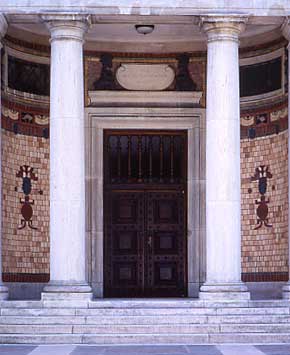
| Old Dr. Barnes was nutty as a fruitcake, but he had lots of money and he loved French Impressionism. He also bought and he bought, and y'know what, nuts though he may have been, he did build a fabulous collection. Click on his picture to read about the Barnes Foundation. |
|
This is what the place looks like from the outside.
Now we're headed in the front door
The grand hall. Look at the Matisse over the French doors -- he called that piece "the rose window of the Foundation."
Here's part of it. I've seen several Matisse works similar to this -- one I remember from the Hermitage in St. Petersburg. Matisse actually visited the Foundation in the 1920's and it took him two years back in Paris to produce a three-piece canvas that would fit the wall at the Barnes. Dr. Barnes was unhappy about having to wait two years, but he was very pleased with the result.
Just look at Dr. Barnes' carefully-planned wall ensembles, each forming a pyramid of masterpieces of art and absurdly twisted bits and pieces of iron.
"What on earth was he thinking," you ask? Apparently he thought "art" could be understood objectively, and he built his foundation to teach the proper method for appreciating it. Room after room filled with fuzzy nekkid fat ladies. And pyramids of art and ironwork.
The painting at the top is called Models and it's by Georges Seurat, who painted the famous A Sunday on La Grande Jatte -- 1884. Notice the more well-known painting (below) is hanging on the wall behind the nude models.
See? See the lady with the bustle on the wall behind the model? You do understand this painting is not at the Barnes, don't you? Just a painting of this painting?
Crazy Dr. Barnes liked French impressionist art and African art. See the long face in the Modigliani? See how it resembles the long narrow faces of African masks? Do you think there's a connection? Me, I dunno.
I could have bought a beautiful print of this Van Gogh portrait of a postman, and I'd have hung it over my dining room table where it could watch over my dinner parties. Patty talked me out of it.
So I said I'd buy this beautiful Monet print to hang over the dining room table, but Patty talked me out of this one too. What's Patty got against fine art?
I'll leave you to contemplate Renoir's fuzzy women and Dr. Barnes' funny twists of iron. |













